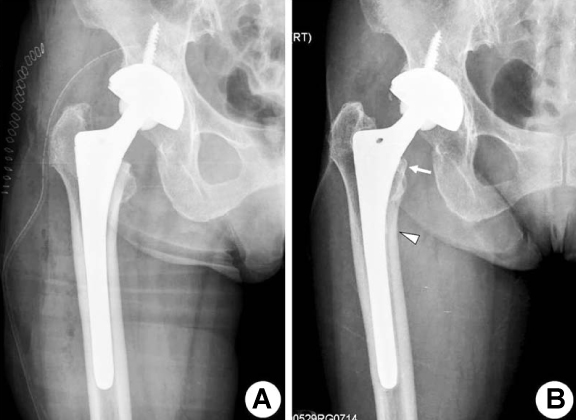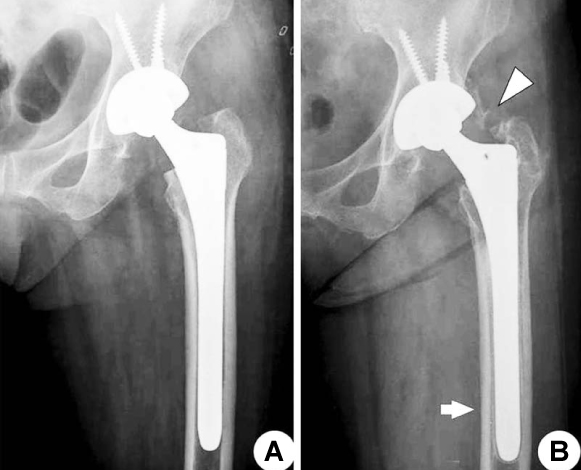J Korean Hip Soc.
2010 Mar;22(1):45-51. 10.5371/jkhs.2010.22.1.45.
Cementless Total Hip Arthroplasty Using VerSys Fiber Metal Midcoat Stem: a Minimum 3-Years Follow-up
- Affiliations
-
- 1Department of Orthopedic Surgery, National Health Insurance Corporation Ilsan Hospital, Ilsan, Korea. hangugy@hanmail.net
- 2Department of Orthopedic Surgery, College of Medicine, Yonsei University, Seoul, Korea.
- KMID: 1461076
- DOI: http://doi.org/10.5371/jkhs.2010.22.1.45
Abstract
- PURPOSE
The purpose of this study was to retrospectively evaluate the results of cementless total hip arthroplasties that used a Versys fiber metal midcoat femoral stem.
MATERIALS AND METHODS
From March 2000 to June 2005, 28 cases in 23 patients were followed up for a minimum of three years. The average follow up period was 5.1 years. Clinical results were evaluated by Harris hip scores. Radiographic analysis was done by evaluating fixation stability, osteolysis, stress shielding, and cortical hypertrophy.
RESULTS
The mean Harris hip score improved from 43.1 to 93.8 at the last follow up. In radiographic analyses of the stem, there was no evidence of positional changes or vertical subsidence. There was heterotopic ossification in four, distal cortical hypertrophy in two, proximal stress shielding in twenty, and femoral osteolysis in five cases. The femoral stem revealed a stable bony ingrowth in all. The acetabular cup revealed a stable bony ingrowth in all. There was no evidence of horizontal or vertical migration or of a change of inclination angle of the acetabular cup.
CONCLUSION
Cementless total hip arthroplasty using a Versys fiber metal midcoat femoral stem showed good clinical and radiologic results, but long term follow up is needed.
MeSH Terms
Figure
Cited by 2 articles
-
Midterm Results of Total Hip Arthroplasty Using the VerSys Fiber Metal Tapered Femoral Stem
Joon Soon Kang, Kyoung-Ho Moon, Bom Soo Kim, Dae Kyu Kwon, Jong Min Choi
Hip Pelvis. 2012;24(2):79-86. doi: 10.5371/hp.2012.24.2.79.The Short-term Clinical Outcome of Total Hip Arthroplasty Using Short Metaphyseal Loading Femoral Stem
Yoo Wang Choi, Sung-Guk Kim
Hip Pelvis. 2016;28(2):82-89. doi: 10.5371/hp.2016.28.2.82.
Reference
-
1. Burkatt BC, Bourne RB, Rorabeck CH, Kirk PG. Thigh pain in cementless total hip arthroplasty. A comparison of two systems at 2 years' follow up. Orthop Clin North Am. 1993. 24:645–653.2. Callaghan JJ, Dysart SH, Svory CG. The uncemented porous-coated anatomic total hip prosthesis. Two-year results of a prospective consecutive series. J Bone Joint Surg Am. 1988. 70:337–346.
Article3. Engh CA, Bobyn JD. The influence of stem size and extent of porous coating on femoral bone resorption after primary cementless hip arthroplasty. Clin Orthop Relat Res. 1998. 231:7–28.
Article4. Sinha RK, Dungy DS, Yeon HB. Primary total hip arthroplasty with a proximally porous-coated femoral stem. J Bone Joint Surg Am. 2004. 86:1254–1261.
Article5. Butler JB, Lansky D, Duwelius PJ. Prospective evaluation of total hip arthroplasty with a cementless, anatomically designed, porous-coated femoral implant: mean 11-year follow-up. J Arthroplast. 2005. 20:709–716.
Article6. Petersilge WJ, D'Lima DD, Walker RH, Colwell CW. Prospective study of 100 consecutive Harris-Galante porous total hip arthroplasties. 4- to 8-year follow-up study. J Arthroplasty. 1997. 12:185–193.
Article7. Dorr LD, Faugere MC, Mackel AM, Gruen TA, Bognar B, Malluche HH. Structural and cellular assessment of bone quality of proximal femur. Bone. 1993. 14:231–242.
Article8. Harris WH. Traumatic arthritis of the hip after dislocation and acetabular fractures: treatment by mold arthroplasty. An end-result study using a new method of result evaluation. J Bone Joint Surg Am. 1969. 51:737–755.
Article9. Brooker Af, Browerman JW, Robinson RA, Riley LH Jr. Ectopic ossification following total hip replacement. Incidence and method of classification. J Bone Joint Surg Am. 1973. 55:1629–1632.10. Engh CA, Bobyn JD, Glassman AH. Porous-coated hip replacement. The factors governing bone ingrowth, stress shielding, and clinical results. J Bone Joint Surg Br. 1987. 69:45–55.
Article11. Tanzer M, Maloney WJ, Jasty M, Harris WH. The progression of femoral cortical osteolysis in association with total hip arthroplasty without cement. J Bone Joint Surg Am. 1992. 74:404–410.
Article12. Gruen TA, McNeice GM, Amstutz HC. "Modes of failure" of cemented stem-type femoral components: a radiographic analysis of loosening. Clin Orthop Relat Res. 1979. 141:17–27.13. Engh CA, Massin P, Suthers KE. Roentgenographic assessment of biologic fixation of porous-surfaced femoral components. Clin Orthop Relat Res. 1990. 257:107–128.14. DeLee JG, Charnley J. Radiological demarcation of cemented sockets in total hip replacement. Clin Orthop Relat Res. 1976. 121:20–32.
Article15. Martell JM, Pierson RH 3rd, Jacobs JJ, Rosenberg AG, Maley M, Galante JO. Primary total hip reconstruction with a titanium fiber-coated prosthesis inserted without cement. J Bone Joint Surg Am. 1993. 75:554–571.
Article16. Archibeck MJ, Berger RA, Jacobs JJ, et al. Second-generation cementless total hip arthroplasty. Eight to eleven-year results. J Bone Joint Surg Am. 2001. 83:1666–1673.17. Bourne RB, Rorabeck CH, Patterson JJ, Guerin J. Tapered titanium cementless total hip replacements: a 10- to 13-year followup study. Clin Orthop Relat Res. 2001. 393:112–120.18. Chen CJ, Xenos JS, McAuley JP, Young A, Engh CA Sr. Second-generation porous-coated cementless total hip arthroplasties have high survival. Clin Orthop Relat Res. 2006. 451:121–127.
Article19. Mont MA, Yoon TR, Krackow KA, Hungerford DS. Clinical experience with a proximally porous-coated second-generation cementless total hip prosthesis: minimum 5-year follow-up. J Arthroplasty. 1999. 14:930–939.
Article20. Gandhi R, Davey JR, Mahomed NN. Hydroxyapatite coated femoral stems in primary total hip arthroplasty: a meta-analysis. J Arthroplasty. 2009. 24:38–42.21. Kim SB, Park SW, Cho HJ, Jung NY. Primary total hip arthroplasty with cementless VerSysfemoral stem: a minimum 5-years follow-up. J Korean Hip Soc. 2007. 19:1–8.
Article22. Vresilovic EJ, Hozack WJ, Rothman RH. Radiographic assessment of cementless femoral components. Correlation with intraoperative mechanical stability. J Arthroplasty. 1994. 9:137–141.23. Engh CA Jr, McAuley JP, Sychterz CJ, Sacco ME, Engh CA Sr. The accuracy and reproducibility of radiographic assessment of stress-shielding. A postmortem analysis. J Bone Joint Surg Am. 2000. 82:1414–1420.
Article24. Bobyn JD, Pilliar RM, Cameron HU, Weatherly GC. The optimum pore size for the fixation of porous-surfaced metal implants by the ingrowth of bone. Clin Orthop Relat Res. 1980. 150:263–270.
Article25. Eingartner C, Volkmann R, Winter E, et al. Results of an uncemented straight femoral shaft prosthesis after 9 years of follow-up. J Arthroplasty. 2000. 15:440–447.
Article26. Jasty M, Bragdon C, Jiranek W, Chandler H, Maloney W, Harris WH. Etiology of osteolysis around porous-coated cementless total hip arthroplasties. Clin Orthop Relat Res. 1994. 308:111–126.
Article27. Heisel C, Silva M, Rosa MA, Schmalzried TP. Short-term in vivo wear of cross-linked polyethylene. J Bone Joint Surg Am. 2004. 86:748–751.
Article
- Full Text Links
- Actions
-
Cited
- CITED
-
- Close
- Share
- Similar articles
-
- Primary Total Hip Arthroplasty with Cementless VerSys Femoral Stem: a Minimum 5-years follow-up
- Midterm Results of Total Hip Arthroplasty Using the VerSys Fiber Metal Tapered Femoral Stem
- Mid-term Results of Primary Cementless Total Hip Arthroplasty with a Fiber Metal Taper Femoral Component and Trilogy Acetabular Cup
- Short Term Results of Cementless Total Hip Arthroplasty With a Tapered Femoral Component
- Metal Debris Induced Osteolysis after Cementless Total Hip Arthroplasty: One case report



